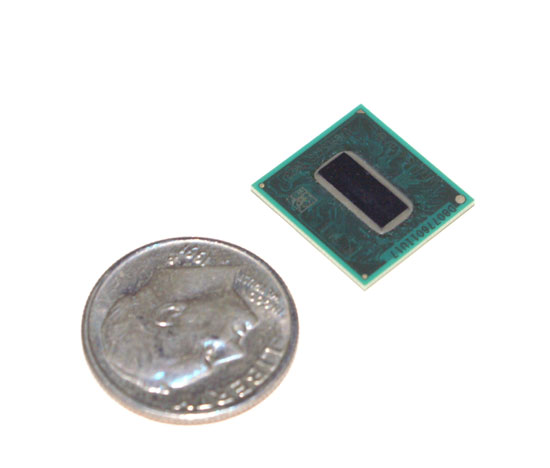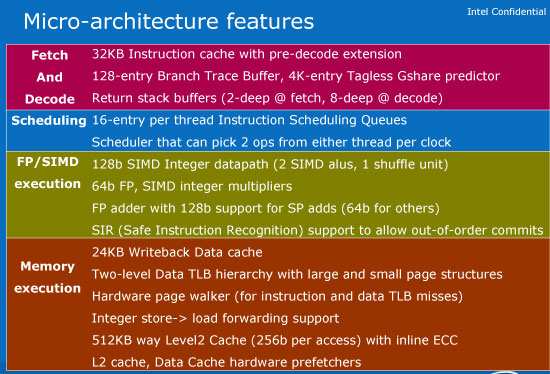Intel's SoC Update: 1B Transistors Embedded in 5 Years
by Anand Lal Shimpi on July 24, 2008 12:00 AM EST- Posted in
- CPUs
It’s announcement day! Well, not really. Intel made a few disclosures about its efforts in the embedded space, but nothing tremendous. It all starts with a little chip called Atom.

Oh, hai. You're bigger than I expected. You know, being called Atom and all.
Intel’s Atom processor is quite possibly Intel’s most important microarchitecture, yet it is hardly discussed - mostly because current implementations are hardly interesting. Today the Atom processor is little more than a very low power x86 chip that performs a lot like a 1.2GHz Pentium M, it’s not exactly setting any speed records.
We’ve already detailed the Atom architecture in depth here, to recap it’s a 2-issue, in-order architecture with SMT support. The goal for Atom has always been to be able to deliver the performance of a 4-year-old Pentium M, in a 1W power envelope. As we found in our initial performance investigation of Atom, Intel was able to sort of meet this goal. At 1.6GHz, the Atom performs somewhere between a 800MHz Pentium M and a 1.6GHz Pentium M - we roughly approximated that to be the performance of a 1.2GHz PM.

The problem is that at 1.6GHz, we’re at a 2W TDP. In order to drop below 1W we have to look at the 800MHz Atom Z500, which not only runs at half the clock speed but also lacks SMT support, which normally delivers a healthy performance increase on the in-order architecture.
So today Atom is hardly interesting beyond some niche markets. ASUS has embraced the chip for its Eee PC and Eee Box machines, but it’s either too slow for a real desktop, or too power hungry (and too large) for things like smartphones. You have to start somewhere though, and that’s what Atom is - a starting point. The next step is where things get more interesting...










13 Comments
View All Comments
sanghab - Wednesday, July 30, 2008 - link
Canmore is not a crude design. It is a second generation SoC for media playback. It's predecessor, the CE2210 was definitely a cruder device and based on an XScale processor. Canmore is highly capable, IA based, and able to decode any video standard, any audio standard or handle multiple HD streams to display and across a home network. It is equally at home handling cable, decoding blu-ray, managing dvr streams and indexing, or working as part of a connected consumer's digital home.wonwhole - Sunday, July 27, 2008 - link
???????ATOM?wonwhole - Sunday, July 27, 2008 - link
????????????When will ATOM go into mobile-phone?
whatthehey - Sunday, July 27, 2008 - link
Can you read? Because I think that was the point of the article, that Moorestown is necessary to make mobile phones an option. The current Atom is way too power hungry, and even worse is that the chipset for it is larger than the CPU (what with the 130nm process). I'd figure on two years minimum before Atom gets into anything like a smartphone.TonyB - Thursday, July 24, 2008 - link
but can it play Crysis?helldrell666 - Thursday, July 24, 2008 - link
in order to open a jpeg file with an eepc you need 24 seconds and 100% of your cpu usage.bla bla bla.
I know this site is funded by INTEL and probably nvidia.
SO, im not gonna complain.
Kepp the good sh. anandtech
lealwai - Thursday, July 24, 2008 - link
.... huh?I don't think he was touting the performance of an eeepc with atom. Merely stating that they were being used. yet, you bring up a totally unrelated point...
JEDIYoda - Thursday, July 24, 2008 - link
AMD fanboi`s tend to do that...JWalk - Friday, July 25, 2008 - link
Fanbois in general tend to do that. If you aren't cheering for their "favorite" company or product, then you must be against them. And then you must be yelled at. Ah, the fun side of the interwebs. ;)Eri Hyva - Thursday, July 24, 2008 - link
1W is totally reasonable in > 1,5GHz with 32nmhttp://www.physorg.com/news109344893.html">http://www.physorg.com/news109344893.html